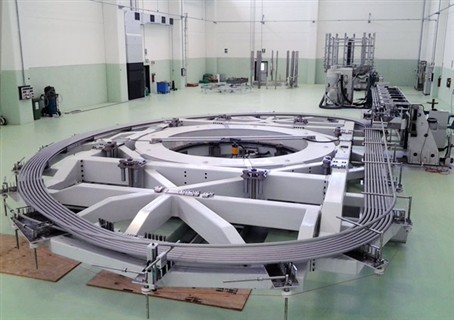First ever full-size prototype of the double pancake for the TF coil has been wound


For the first time ever, a Toroidal Field (TF) coil full-size super-conducting prototype of the double pancake (DP) is being manufactured, and the first step of the manufacturing process, winding, was completed at the beginning of August. This milestone, which was carried out at the ASG premises in La Spezia, Italy, follows the production of the winding line.
The ITER device will operate with a system of superconducting magnets which relies on the TF coils, the central solenoid, the Poloidal Field coils and the correction coils. F4E is responsible for procuring 10 TF coils (Japan will contribute an additional nine TF coils) — ‘D’ shaped coils which will be operated with an electrical current of 68 000 amps in order to produce the magnetic field which confines and holds the plasma in place in the ITER tokamak. Each TF coil weighs about 300 t and is about 16.5 m tall and 9.5 m wide.
Each TF coil contains in total seven DPs which produce the magnetic field (two DPs which contain cable-in-conduit conductors measuring 450 m and five DPs where the conductors measure 750 m in length). Each DP is composed of a conductor length, which carries the electrical current, and of a stainless steel D-shaped plate called a radial plate, which holds and mechanically supports the conductor through groves machined on both sides along a spiral trajectory. The conductor is composed of about 1 000 superconducting and copper wires cabled inside a 2 mm-thick round stainless steel jacket 43.7 mm in diameter.
The winding of the DP, the most challenging component in the TF coil from the manufacturing point of view, consists of bending the conductor length along a D-shaped double spiral trajectory. As it is necessary that the DP conductor fit precisely inside the radial plate groove, it is vital to control the trajectory of the conductor in the DP and the trajectory of the groove in the radial plate with an extremely high level of accuracy. In particular, the trajectory of the conductor must be controlled with an accuracy as high as 0.01 %, and this is why the winding line utilises a numerically controlled bending unit as well as laser-based technology to measure the position and the dimensions of the conductor. The winding takes place in an environment with a controlled temperature of 20 °C ± 1 °C, and at an average speed of 5 m of conductor length per hour.
A consortium composed of the Italian company ASG and the Spanish companies Iberdrola and Elytt is responsible for the manufacturing of the prototype as well as the future actual DPs. With the winding of the prototype now completed, other manufacturing steps are needed: the DP will be heat-treated at 650 °C in a specially constructed inert atmosphere oven, then electrically insulated and finally transferred into the grooves of the stainless-steel radial plates. After assembly and the application of electrical insulation on the outside of the radial plate, the module is finally impregnated with special radiation-resistant epoxy resin, thus forming the prototype DP module. This work is scheduled to be completed by the beginning of next year and will then allow for the prototype to be tested by being cooled to – 77 °K in order to assess the effect of the low temperature. It will then be cut into sections in order to analyse the quality of the impregnation of the insulation of the superconducting conductor.